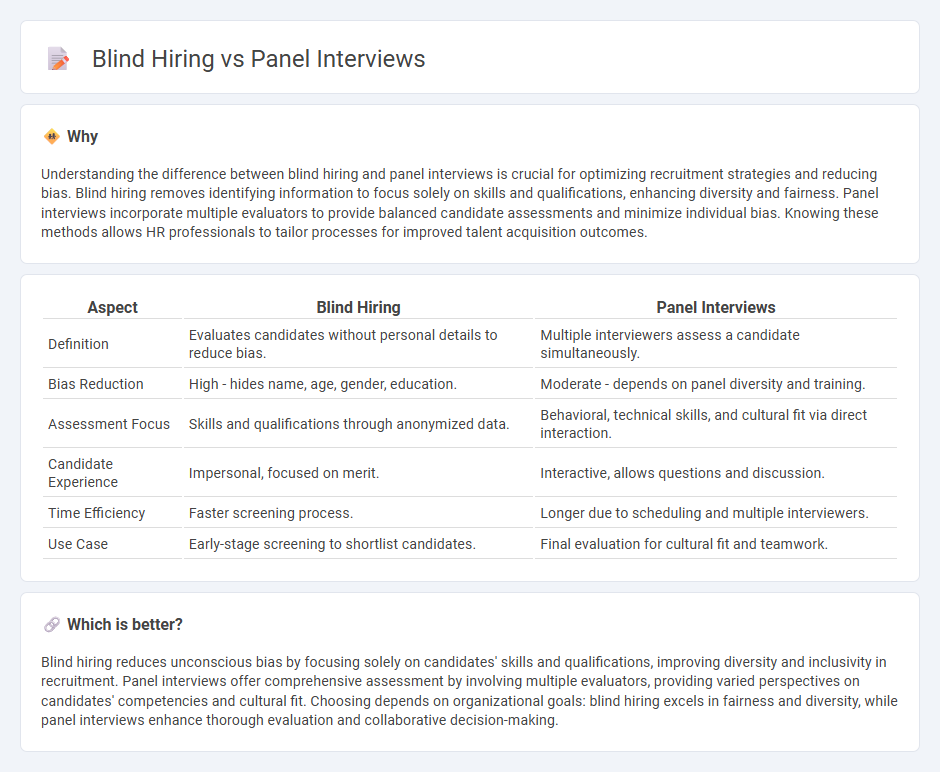
Blind hiring eliminates bias by removing personal information from candidate evaluations, focusing solely on skills and qualifications to enhance diversity and inclusion. Panel interviews gather insights from multiple interviewers, providing a well-rounded assessment of a candidate's fit and competencies through collaborative decision-making. Explore more on how these strategies impact recruitment effectiveness and workforce diversity.
Why it is important
Understanding the difference between blind hiring and panel interviews is crucial for optimizing recruitment strategies and reducing bias. Blind hiring removes identifying information to focus solely on skills and qualifications, enhancing diversity and fairness. Panel interviews incorporate multiple evaluators to provide balanced candidate assessments and minimize individual bias. Knowing these methods allows HR professionals to tailor processes for improved talent acquisition outcomes.
Comparison Table
| Aspect | Blind Hiring | Panel Interviews |
|---|---|---|
| Definition | Evaluates candidates without personal details to reduce bias. | Multiple interviewers assess a candidate simultaneously. |
| Bias Reduction | High - hides name, age, gender, education. | Moderate - depends on panel diversity and training. |
| Assessment Focus | Skills and qualifications through anonymized data. | Behavioral, technical skills, and cultural fit via direct interaction. |
| Candidate Experience | Impersonal, focused on merit. | Interactive, allows questions and discussion. |
| Time Efficiency | Faster screening process. | Longer due to scheduling and multiple interviewers. |
| Use Case | Early-stage screening to shortlist candidates. | Final evaluation for cultural fit and teamwork. |
Which is better?
Blind hiring reduces unconscious bias by focusing solely on candidates' skills and qualifications, improving diversity and inclusivity in recruitment. Panel interviews offer comprehensive assessment by involving multiple evaluators, providing varied perspectives on candidates' competencies and cultural fit. Choosing depends on organizational goals: blind hiring excels in fairness and diversity, while panel interviews enhance thorough evaluation and collaborative decision-making.
Connection
Blind hiring eliminates bias by anonymizing candidate information such as name, gender, and ethnicity, enabling objective assessment of skills and qualifications. Panel interviews complement this approach by incorporating diverse perspectives from multiple interviewers, which further reduces individual biases and promotes fair evaluation. Together, these methods enhance equitable talent acquisition and improve overall hiring effectiveness in human resources.
Key Terms
Interviewer Bias
Panel interviews reduce interviewer bias by involving multiple evaluators, ensuring diverse perspectives and balanced judgments during candidate assessment. Blind hiring eliminates bias by anonymizing candidate information, focusing solely on skills and experience without influence from demographic or personal details. Explore deeper insights on minimizing interviewer bias and improving hiring practices.
Anonymity
Panel interviews bring diverse perspectives, reducing individual biases during candidate evaluation, but often lack complete anonymity, potentially revealing personal information that influences decisions. Blind hiring ensures candidate anonymity by removing identifiable details like names and photos, fostering a fairer assessment based solely on skills and experience. Explore how integrating both methods can optimize hiring fairness and effectiveness in your organization.
Structured Evaluation
Panel interviews enable structured evaluation by involving multiple evaluators who assess candidates simultaneously using standardized criteria, reducing individual bias and improving decision consistency. Blind hiring removes identifiable candidate information to focus solely on skills and qualifications, enhancing fairness and promoting diversity in the hiring process. Explore the benefits of combining panel interviews with blind hiring techniques for a more objective and effective recruitment strategy.
Source and External Links
Panel Interview - Oleeo - A panel interview involves two or more interviewers from different departments assessing a single candidate to gain a broader perspective and ensure a well-rounded hiring decision.
How to Get the Most Out of a Panel Interview - DDI - In a panel interview, multiple interviewers such as the hiring manager, team members, and HR evaluate a candidate's competencies and fit in one session, differing from group interviews where multiple candidates are assessed together.
The Advantages and Disadvantages of Panel Interviews - 4 Corner Resources - Panel interviews incorporate feedback from diverse sources, often feature rotating questioners covering various topics, and are commonly used for technical or cross-departmental roles.
 dowidth.com
dowidth.com